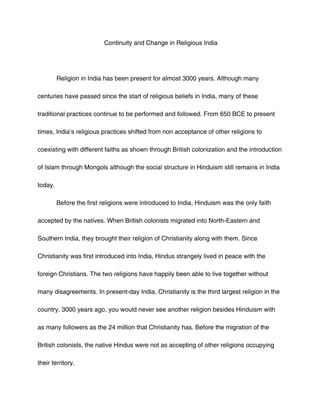
Change paper
- 1. Continuity and Change in Religious India Religion in India has been present for almost 3000 years. Although many centuries have passed since the start of religious beliefs in India, many of these traditional practices continue to be performed and followed. From 650 BCE to present times, India’s religious practices shifted from non acceptance of other religions to coexisting with different faiths as shown through British colonization and the introduction of Islam through Mongols although the social structure in Hinduism still remains in India today. Before the first religions were introduced to India, Hinduism was the only faith accepted by the natives. When British colonists migrated into North-Eastern and Southern India, they brought their religion of Christianity along with them. Since Christianity was first introduced into India, Hindus strangely lived in peace with the foreign Christians. The two religions have happily been able to live together without many disagreements. In present-day India, Christianity is the third largest religion in the country. 3000 years ago, you would never see another religion besides Hinduism with as many followers as the 24 million that Christianity has. Before the migration of the British colonists, the native Hindus were not as accepting of other religions occupying their territory.
- 2. Therefore; when the Mongols took over control of India, the religion of Islam spread throughout India. The Quran’s teachings were enough for the religion to become the second most followed religion after Hinduism in India. Similar to Christianity, Islam was accepted by the people of India which would not have been common before these two religions migrated into the area. One of the clearest and most obvious continuities in India is the social structure. Hindus follow the Caste System which basically divides up the social classes in society with the highest caste being the priests and the lowest class being the peasants. The Caste System first came into play when Hinduism was introduced into India in 650 BCE. Over time, the Caste System is still to this day practiced by the Hindu followers all across India. Many might believe that because the Caste System was outlawed in 1949 that it is no longer in effect. Actually, the Caste System is still practiced secretly and heavily by the followers of Hinduism. The Caste System has remained important to Indian society because of the way it divided up the people into social classes. One’s dharma and karma continue to play a major role in the social stand point of India as well. “Dharma” means one’s duty or role in life and it related directly to the Caste System. Members of the pyramid are expected to perform their dharma well in hopes of receiving good karma. Also, the practice of pacifism or non-violence is seen throughout India. The Hindus, Jainists, and other religious followers believe in peace between each
- 3. be constantly changing or remaining constant, but no one can predict which practices will truly be the same forever.